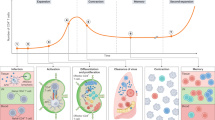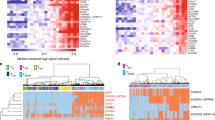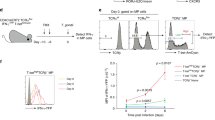Abstract
Immunological memory depends on the long-term maintenance of memory T cells. Although the factors that maintain CD8 T cell memory are well understood, those responsible for CD4 memory are not well defined. We have shown here that interleukin 7 (IL-7) was an important survival factor for CD4 memory T cells that together with T cell receptor (TCR) signals regulated homeostasis of the CD4 memory population in lymphopenic conditions and in the intact immune system. Thus, IL-7 contributes to the maintenance of all naive and memory T cell subsets, and therefore controls the overall size of the T cell pool.
This is a preview of subscription content, access via your institution
Access options
Subscribe to this journal
Receive 12 print issues and online access
$209.00 per year
only $17.42 per issue
Buy this article
- Purchase on Springer Link
- Instant access to full article PDF
Prices may be subject to local taxes which are calculated during checkout





Similar content being viewed by others
References
Freitas, A.A. & Rocha, B. Population biology of lymphocytes: the flight for survival. Annu. Rev. Immunol. 18, 83–111 (2000).
Schluns, K.S., Kieper, W.C., Jameson, S.C. & Lefrancois, L. Interleukin-7 mediates the homeostasis of naive and memory CD8 T cells in vivo. Nat. Immunol. 1, 426–432 (2000).
Vivien, L., Benoist, C. & Mathis, D. T lymphocytes need IL-7 but not IL-4 or IL-6 to survive in vivo. Int. Immunol. 13, 763–768 (2001).
Tan, J.T. et al. IL-7 is critical for homeostatic proliferation and survival of naive T cells. Proc. Nat. Acad. Sci. USA 98, 8732–8737 (2001).
Seddon, B. & Zamoyska, R. TCR signals mediated by Src family kinases are essential for the survival of naive T cells. J. Immunol. 169, 2997–3005 (2002).
Tanchot, C., Lemonnier, F.A., Perarnau, B., Freitas, A.A. & Rocha, B. Differential requirements for survival and proliferation of CD8 naive or memory T cells. Science 276, 2057–2062 (1997).
Kirberg, J., Berns, A. & von Boehmer, H. Peripheral T cell survival requires continual ligation of the T cell receptor to major histocompatibility complex-encoded molecules. J. Exp. Med. 186, 1269–1275 (1997).
Brocker, T. Survival of mature CD4 T lymphocytes is dependent on major histocompatibility complex class II-expressing dendritic cells. J. Exp. Med. 186, 1223–1232 (1997).
Viret, C., Wong, F.S. & Janeway, C.A., Jr. Designing and maintaining the mature TCR repertoire: the continuum of self-peptide:self-MHC complex recognition. Immunity 10, 559–568 (1999).
Rooke, R., Waltzinger, C., Benoist, C. & Mathis, D. Targeted complementation of MHC class II deficiency by intrathymic delivery of recombinant adenoviruses. Immunity 7, 123–134 (1997).
Witherden, D. et al. Tetracycline-controllable selection of CD4+ T cells: half-life and survival signals in the absence of major histocompatibility complex class II molecules. J. Exp. Med. 191, 355–364 (2000).
Goldrath, A.W. & Bevan, M.J. Low-affinity ligands for the TCR drive proliferation of mature CD8+ T cells in lymphopenic hosts. Immunity 11, 183–190 (1999).
Kieper, W.C. & Jameson, S.C. Homeostatic expansion and phenotypic conversion of naive T cells in response to self peptide/MHC ligands. Proc. Natl. Acad. Sci. USA 96, 13306–13311 (1999).
Ernst, B., Lee, D.S., Chang, J.M., Sprent, J. & Surh, C.D. The peptide ligands mediating positive selection in the thymus control T cell survival and homeostatic proliferation in the periphery. Immunity 11, 173–181 (1999).
Murali-Krishna, K. et al. Persistence of memory CD8 T cells in MHC class I-deficient mice. Science 286, 1377–1381 (1999).
Zhang, X., Sun, S., Hwang, I., Tough, D.F. & Sprent, J. Potent and selective stimulation of memory-phenotype CD8+ T cells in vivo by IL-15. Immunity 8, 591–599 (1998).
Ku, C.C., Murakami, M., Sakamoto, A., Kappler, J. & Marrack, P. Control of homeostasis of CD8+ memory T cells by opposing cytokines. Science 288, 675–678 (2000).
Becker, T.C. et al. Interleukin 15 is required for proliferative renewal of virus-specific memory CD8 T cells. J. Exp. Med. 195, 1541–1548 (2002).
Tan, J.T. et al. Interleukin (IL)-15 and IL-7 jointly regulate homeostatic proliferation of memory phenotype CD8+ cells but are not required for memory phenotype CD4+ cells. J. Exp. Med. 195, 1523–1532 (2002).
Goldrath, A.W. et al. Cytokine requirements for acute and basal homeostatic proliferation of naive and memory CD8+ T cells. J. Exp. Med. 195, 1515–1522 (2002).
Kieper, W.C. et al. Overexpression of interleukin (IL)-7 leads to IL-15-independent generation of memory phenotype CD8+ T cells. J. Exp. Med. 195, 1533–1539 (2002).
Swain, S.L., Hu, H. & Huston, G. Class II-independent generation of CD4 memory T cells from effectors. Science, 1381–1383 (1999).
Polic, B., Kunkel, D., Scheffold, A. & Rajewsky, K. How αβ-T cells deal with induced TCR-α ablation. Proc. Natl. Acad. Sci. USA 98, 8744–8749 (2001).
Tan, J.T. et al. Interleukin (IL)-15 and IL-7 jointly regulate homeostatic proliferation of memory phenotype CD8+ cells but are not required for memory phenotype CD4+ cells. J. Exp. Med. 195, 1523–1532 (2002).
Lantz, O., Grandjean, I., Matzinger, P. & Di Santo, J.P. γ chain required for naive CD4+ T cell survival but not for antigen proliferation. Nat. Immunol. 1, 54–58 (2000).
Jameson, S.C. Maintaining the norm: T-cell homeostasis. Nat. Rev. Immunol. 2, 547–556 (2002).
Dorfman, J.R., Stefanova, I., Yasutomo, K. & Germain, R.N. CD4+ T cell survival is not directly linked to self-MHC-induced TCR signaling. Nat. Immunol. 1, 329–335 (2000).
Legname, G. et al. Inducible expression of a p56Lck transgene reveals a central role for Lck in the differentiation of CD4 SP thymocytes. Immunity 12, 537–546 (2000).
Swanson, B.J., Murakami, M., Mitchell, T.C., Kappler, J. & Marrack, P. RANTES production by memory phenotype T cells is controlled by a posttranscriptional, TCR-dependent process. Immunity 17, 605–615 (2002).
Swain, S.L. et al. Helper T-cell subsets: phenotype, function and the role of lymphokines in regulating their development. Immunol. Rev. 123, 115–144 (1991).
Sprent, J. T and B memory cells. Cell 76, 315–322 (1994).
Thomis, D.C., Gurniak, C.B., Tivol, E., Sharpe, A.H. & Berg, L.J. Defects in B lymphocyte maturation and T lymphocyte activation in mice lacking Jak3. Science 270, 794–797 (1995).
Cao, X. et al. Defective lymphoid development in mice lacking expression of the common cytokine receptor gamma chain. Immunity 2, 223–238 (1995).
Nakajima, H., Shores, E.W., Noguchi, M. & Leonard, W.J. The common cytokine receptor γ-chain plays an essential role in regulating lymphoid homeostasis. J. Exp. Med. 185, 189–195 (1997).
Peschon, J.J. et al. Early lymphocyte expansion is severely impaired in interleukin 7 receptor-deficient mice. J. Exp. Med. 180, 1955–1960 (1994).
Maraskovsky, E. et al. Impaired survival and proliferation in IL-7 receptor-deficient peripheral T cells. J. Immunol. 157, 5315–5323 (1996).
von Freeden-Jeffry, U. et al. Lymphopenia in interleukin (IL)-7 gene-deleted mice identifies IL-7 as a nonredundant cytokine. J. Exp. Med. 181, 1519–1526 (1995).
Tough, D.F. & Sprent, J. Turnover of naive- and memory-phenotype T cells. J. Exp. Med. 179, 1127–1135 (1994).
Seddon, B., Legname, G., Tomlinson, P. & Zamoyska, R. Long-term survival but impaired homeostatic proliferation of naive T cells in the absence of p56lck. Science 290, 127–131 (2000).
Gozalo-Sanmillan, S., McNally, J.M., Lin, M.Y., Chambers, C.A. & Berg, L.J. Cutting edge: two distinct mechanisms lead to impaired T cell homeostasis in Janus kinase 3- and CTLA-4-deficient mice. J. Immunol. 166, 727–730 (2001).
Kassiotis, G., Garcia, S., Simpson, E. & Stockinger, B. Impairment of immunological memory in the absence of MHC despite survival of memory T cells. Nat. Immunol. 3, 244–250 (2002).
Seddon, B. & Zamoyska, R. TCR and IL-7 receptor signals can operate independently or synergize to promote lymphopenia-induced expansion of naive T cells. J. Immunol. 169, 3752–3759 (2002).
Acknowledgements
We thank T. Norton, K. Williams and the Biological Services staff for assistance with mouse breeding and typing. We also thank B. Stockinger and G. Kassiotis, as well as other members of the Division of Molecular Immunology, for discussions. This work was supported by the Medical Research Council and the Leukaemia Research Fund, UK.
Author information
Authors and Affiliations
Corresponding author
Ethics declarations
Competing interests
The authors declare no competing financial interests.
Supplementary information
Rights and permissions
About this article
Cite this article
Seddon, B., Tomlinson, P. & Zamoyska, R. Interleukin 7 and T cell receptor signals regulate homeostasis of CD4 memory cells. Nat Immunol 4, 680–686 (2003). https://doi.org/10.1038/ni946
Received:
Accepted:
Published:
Issue Date:
DOI: https://doi.org/10.1038/ni946
This article is cited by
-
Learning from Persistent Viremia: Mechanisms and Implications for Clinical Care and HIV-1 Cure
Current HIV/AIDS Reports (2023)
-
The signal pathways and treatment of cytokine storm in COVID-19
Signal Transduction and Targeted Therapy (2021)
-
The forces driving clonal expansion of the HIV-1 latent reservoir
Virology Journal (2020)
-
Flip the coin: IL-7 and IL-7R in health and disease
Nature Immunology (2019)
-
Tyrosine Kinase Inhibition: a New Perspective in the Fight against HIV
Current HIV/AIDS Reports (2019)



